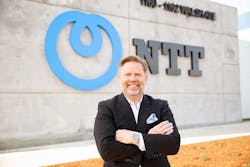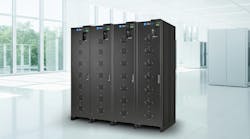The Hypergrowth Journey of NTT Global Data Centers Americas
The growth of the Internet has transformed the global economy, changing how we shop, learn and do business. This growth has also been transformative for the companies that build the Internet.
In the case of NTT Global Data Centers Americas (GDCA), it all began with a single data center in Sacramento operated by RagingWire. The company now operates 1.5 million square feet of data centers space across seven U.S. campuses, with another 3 million square feet under development. It is part of NTT Global Data Centers, which is the world’s third-largest data center provider with more than 140 data centers across the world.
The U.S. building boom is the realization of a growth strategy developed by Doug Adams, now the President and CEO of NTT GDCA. That vision gained momentum Japanese telecom company NTT acquired a majority stake in RagingWire. Adams was already seeing the IT landscape being transformed by huge global cloud platforms, and the capital strength of NTT allowed the RagingWire team to dream bigger.
DCF editor Rich Miller recently spoke with Adams about NTT’s data center growth. Here’s the video of our conversation, produced with NTT Global Data Centers Americas:
TRANSCRIPT:
Rich Miller, Data Center Frontier: I’m here with Doug Adams, the CEO of NTT Global Data Centers Americas. And we’re talking about the the growth of the data center industry and how we have known one another for a while.
Doug Adams, President and CEO of NTT GDCA: We didn’t have gray hair when we first met each other.
Rich Miller: That’s true. Well, maybe I had a few, but a lot has changed. Obviously there’s been fantastic growth for the industry. You started out a while back with RagingWire in a single data center in Sacramento. Share a little bit about what this whole journey has been like and some of the things that you’ve seen change.
Doug Adams: We started almost 22 years ago. And when we started, there really wasn’t much of an industry at the beginning. I was responsible for sales and marketing. We were entrepreneurs, so we were a lot of hats. And one of the hats I actually wore was operations, believe or not. So I was available for sales, marketing and operations, which I know is a very unusual combination.
When we started, as you said, we were in Sacramento and only had one facility. We branched out with a facility here in Ashburn, Virginia. And that was really the beginning point for business exploding. Now, fast forward to 2013. We had a successful transaction where we sold 80% of the company to NTT. Eventually we sold the remaining 20% and that was really the inflection point for our business.
We moved from just having our Sacramento and our Virginia facilities to opening up a facility in Texas. After that, we opened up facilities in Chicago and Hillsboro, Silicon Valley and Phenix. So that capital and lifeblood we got from NTT was really what what caused the journey of hypergrowth that we’ve experienced over the last five years.
NTT Global Data Centers Americas CEO Doug Adams (left) and Data Center Frontier Editor Rich Miller inside the company’s VA3 data center in Ashburn, Virginia. (Photo: NTT DGCA)
Rich Miller: Some of the changes in the industry haven’t just been about growth and being in more places, with bigger data centers and more capital. Some of it is really that the customers themselves have changed, and how you serve them has led to some strategic shifts in how you go about building and operating in data center. Tell me a little bit about how you’ve tried to adapt the organization to accommodate this change.
Doug Adams: We have constantly changed and been very agile as an organization. One of the ways that we manage our business is that every year we look at the business and we reallocate our assets based on where we think the business is growing. Early on we developed the attitude that if we were going to be successful, we would really need to listen to our customers and do what they were looking for us to do.
As I look at the evolution of us as a company, we really started in retail (colocation), then we quickly moved to Enterprise and then came the the “dot com” movement, when you started to see all the online retailing with Amazon and the different hyperscalers started to emerge. Frankly, we took a step back because we were a bricks-and-mortar enterprise, and the players that were concentrating on on the hyperscalers and the Internet digital economy started to grow faster than us.
We brought on some amazing staff members that understood and had experienced how to work in the hyperscale market. We standardized our product. We standardized our supply chain. We made all those moves. We bought land in the right markets, and morphed our ourselves into a more hyperscale/enterprise centric business. That was really the key turning point for us. And of course, the acquisition by NTT and getting that capital to grow the business were the real turning points for us.
Rich Miller: One of the things I always like to look at is the data center itself, as a prism, because it always tells you something about the business and how companies are approaching it. The design you’ve used has changed quite a bit over the last 5 to 10 years. Tell me a little bit about how data centers are built and designed has evolved.
Doug Adams: So we’re sitting in our Ashburn, Virginia VA3 facility. I think it’s one of our most beautiful facilities. I love this facility, and we built this when we were really not very well known and didn’t have a strong level of branding. So we tried to reinforce the fact that we were a larger company and reinforce our branding by building absolutely gorgeous facilities.
And I think we accomplished it, especially with this facility. People viewed us as being one of the larger, more premier players, even though at the time we may not have been. We are now. We’re part of the third-largest global footprint of data centers. NTT is now a powerhouse in the data center business.
We still build beautiful data centers, and they’re very practical and designed for large enterprise and hyperscalers. We have loading docks that can accommodate 10-foot racks, things that are more germane to that hyperscale and enterprise client. These are 36-megawatt building blocks.
The new design is highly fungible. We take a prefabricated building and while we’re building it, we have a factory that creates our electrical and mechanical modules, and then we merge them together. So if we want to speed up our building in Portland and slow down our building in Virginia, we’re able to do that. All of our building is accelerated. That fungibility is great. But we’re exploding everywhere, in all of our markets.
Rich Miller: That brings me back to one of the things that has really changed with the data center market. Back in 2000 when you got started, a small team could begin building something that could grow over time. Nowadays in the data center business, scale really matters, both in terms of investment and capital. So in that respect, how has the relationship with NTT served to help you in building out a data center company that can serve a wide range of some of the world’s biggest customers?
Doug Adams: NTT has a regional breadth that is amazing. Customers can now come to us and we can accommodate their data center needs. We have divisions that manage private clouds. We can provide security or managed services for them. There’s a whole set of features and products and solutions that we can bring to bear for our clients.
So our clients can sign one MSA (Master Service Agreement) or one SLA (Service Level Agreement) and have infrastructure in Frankfurt, Tokyo, London, Ashburn, Dallas, Texas with one contract. It is like hitting the easy button, so it’s made things a lot simpler for them.
In addition to that, NTT is one of the 50 largest companies globally over $100 billion worth of revenue on an annual basis. So that triple-A credit rating and access to capital allows us to service the largest companies, allows us to land bank, allows us to build these large campuses quickly. It’s really morphed to change the business in a way that, frankly, I didn’t see 10 years ago.
An aerial view of the NTT Global Data Centers Americas VA4 facility in Ashburn, VIrginia. (Photo: NTT GDCA)
Rich Miller: You’ve talked about how you wear a lot of different hats and have had a lot of different experiences. One of the things about your journey is that you’ve taken on more and more responsibility. How have you looked at the leadership process itself and and approached trying to lead this company and work with the people that execute the mission?
Doug Adams: My thinking and viewpoint has matured a lot. In the early days I was really focused on standardized design and the supply chain. Over the last 10 years, I realized that the key differentiator for us and every one of our competitors really is the staff and the people. Everything starts with the employees, and if you do a good job there, there will be a great customer experience.
I think a lot of people do the opposite, and try to focus on customer experience without taking care of their employees. I believe that that creating a strong culture of service is important to running a business. It’s taken us a while to do that, but we’ve done it, and I think it shows in our products and services.
Rich Miller: There’s been a lot of change over the past 10 years, and the past 20 years. It has been quite a ride. I appreciate you sharing your story with us because it’s it’s been an interesting one. And we’ll have to see where things go from here. Who knows what the future holds for the data center?
Doug Adams: I’m super excited. I think this industry is going to continue to grow and grow strong for the next ten years.
Rich Miller: Then we can do this again.
Doug Adams: Yeah, that will be fun. We should we should schedule that now.


